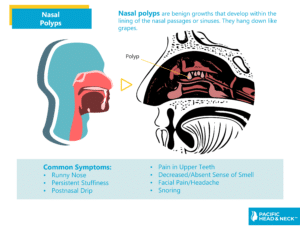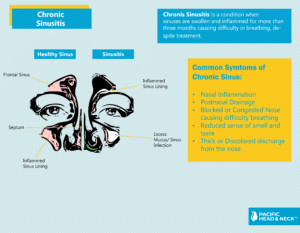
A 65-year-old male with a history of environmental allergies has experienced a long history of post-nasal drip, facial pressure around his nose and eyes, difficulty breathing through his nose, and a decreased sense of smell. He has had multiple episodes of acute sinus infections with associated yellow discharge from his nose and discolored post-nasal drip. These episodes are often treated with courses of antibiotics and steroids. The patients baseline symptoms of nasal congestion and facial pressure have never been completely resolved. He uses Flonase and a Netipot almost on a daily basis.
Examination
Per a nasal endoscopy examination, the findings revealed were inflammation of the lining of the nose, clear mucus drainage, and a large amount of benign nasal polyps filling both nasal cavities.
A CT scan was also performed, which confirmed a chronic sinus infection with extensive nasal polyps blocking the sinus outflow tracts preventing them from draining appropriately. This build up of polyps, back up of mucus outflow and sinus inflammation leads to this patient’s symptoms of:
- Nasal congestion
- Nasal drainage
- Post-nasal drip
- Facial pressure
- Decreased sense of smell
Treatment
Given that the patient had failed conservative medical therapy with nasal sprays, nasal saline rinses, oral steroids and antibiotics the decision was made to proceed with endoscopic sinus surgery and nasal polyp removal.

Discussion
What is the treatment for nasal polyps?
We always like to start conservatively when treating patients with nasal polyps. This includes using steroid nasal sprays or rinses, such as Flonase or Nasonex, on a daily basis. A saline rinse such as NeilMed sinus rinse or a NetiPot has also shown to be beneficial in patients with chronic sinus issues. When patients have exacerbation in their symptoms we will often prescribe short courses of oral steroids, such as prednisone, as well as oral antibiotics.
When the above medical therapy fails, however, surgery is usually the next best step. Nasal polyp surgery is typically an outpatient procedure done under general anesthesia. During the procedure, which is done without any external excision, the ENT surgeon will insert an endoscope through the nose to view the nasal and sinus passages. The surgeon will then use micro-surgical instruments through the nose to remove the nasal polyps and open the nasal passages and sinus outflow tracts.
This type of endoscopic sinus surgery is an ideal solution for those patients who fail medical therapy. The surgery is generally well tolerated and minimally invasive. Recovery time includes a few days of pain and 2-3 weeks of congestion and crusting. However, when that recovery period is over most patients will notice that all of their previous symptoms of nasal congestion, facial pressure, post-nasal drip and decreased sense of smell have resolved.

For more information, please visit our Chronis Sinusitis, Nasal Polyps, or complete the form below.







